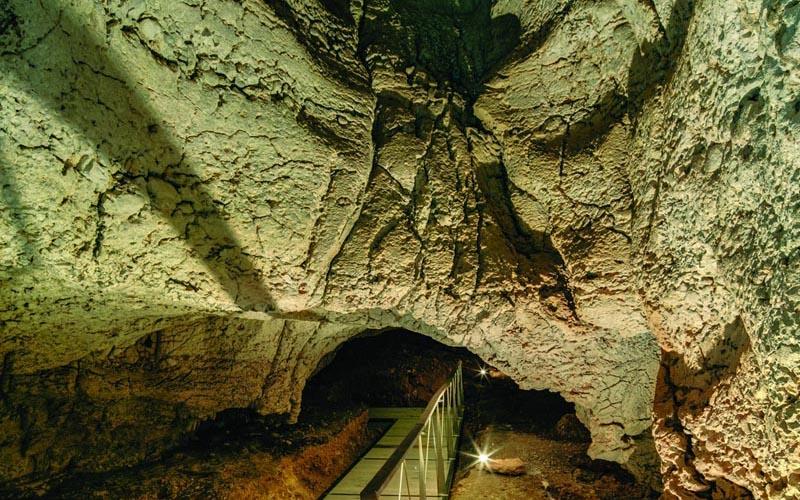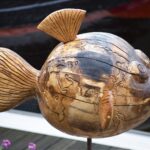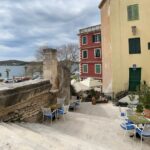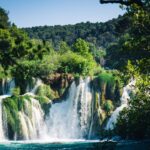Krka National Park is one of the most visited national parks in Croatia when it comes to touring and visiting Central Dalmatia. Krka waterfalls is extremely famous for its large number of lakes and waterfalls, but also for its geomorphological peculiarity, which makes it one of the favorite natural attractions in Dalmatia. Krka National Park is named after the Krka River, which forms a part of the park, and the park itself is located a few kilometers northeast of the town of Šibenik. Krka Waterfalls today contains 7 travertine waterfalls that make it one of the most beautiful natural attractions of the area but also one of the most beautiful natural karst phenomena in Croatia. Krka National Park was declared a national park on 24 January 1985 and is the seventh national park in the Republic of Croatia.
Krka National Park is a large area containing diverse habitats, and one part of this habitat is caves and pits, of which about forty are located in the national park area. The science that studies caves and caves is called speleology, and it denotes a set of activities aimed at exploring underground karst phenomena. Speleology mostly involves research based on geological, morphological, hydrological, physical, and other characteristics of a particular area, and the collection of documentation for this purpose. Cave scientists, therefore, study the processes of cave formation and the rich cave fauna.
Krka National Park contains a large number of pits and caves, which are mostly smaller in size and are located in travertine barriers. A large number of these speleological barriers are in the upper Cretaceous limestones and were created by tectonic cracks over time.
Some of the caves are:
The source of the cave Miljacka
Miljacka Cave is the largest cave in the vicinity of Miljacka Waterfall. The cave is located on the right side of the river, just a few hundred meters downstream from the waterfall. During high waters, an underground river flows through the Miljacka Cave, and while the waters are low, a lake is formed about 200 meters long. The Miljacka Cave is 1750 meters long and contains 36 underground taxa, the vast majority of which are endemic to Croatia because the cave represents an ideal underground habitat. This cave is home to 8 taxa of bats and an endemic amphibian of olm.
Pit opposite side of lake Torak
This pit is located on the right side of the Cikola River, 10 meters long and 20 meters deep. The cave is considered to be submerged by rising lake levels after travertine barriers in the Krka National Park. There are three lakes at the bottom of the cave, the largest is about 17 meters deep. This pit also represents home to the olm and other endemic species.
Oziđana cave and Jazinka
These two caves represent a place where human traces have been found.. The Cave Oziđana is located above Roška Waterfall, on the left bank of the Krka River. The cave is tunnel-shaped and contains bones of people, different animals, mussel shells, stone tools and more. Jazinka is also located on the left bank of the Krka River near the Necven fort, and ceramic vessels and human bones dating back to the Bronze Age have also been found there.
Nameless cave
This cave was discovered in 1894 and is located along Skradinski Buk on the left bank of the Krka River. The cave was discovered at the time of the construction of the hydroelectric power plant in Krka National Park, and according to records from that time it was discovered that the cave was 150 meters long and 80 meters wide. It is believed that the cave was formed by the deposition of tufa, and at the bottom of the cave was a small lake. Today, the remains of the hydroelectric foundation can be seen in this cave.
When it comes to other speleological objects in and near the Krka National Park, the most prominent are the Martina Cave, which is actually a cave with a vertical entrance, and the Old Pit, which is the deepest cave along the river Krka.
Walk along the trail made from wooden planks, above the clear lakes and torrents, between the ancient trees rooted deep in the water and explore the caves and pits hidden in the forest. Feel the power of nature as you gaze at the majestic waterfalls. Explore historic watermills along the way and enjoy the unforgettable Krka Waterfalls from the Split tour, which is considered one of the best things to do in Split!
Check out our tour Krka Waterfalls from Split on the link below!
Literature:
http://www.np-krka.hr/stranice/speleological-structures/70/en.html




